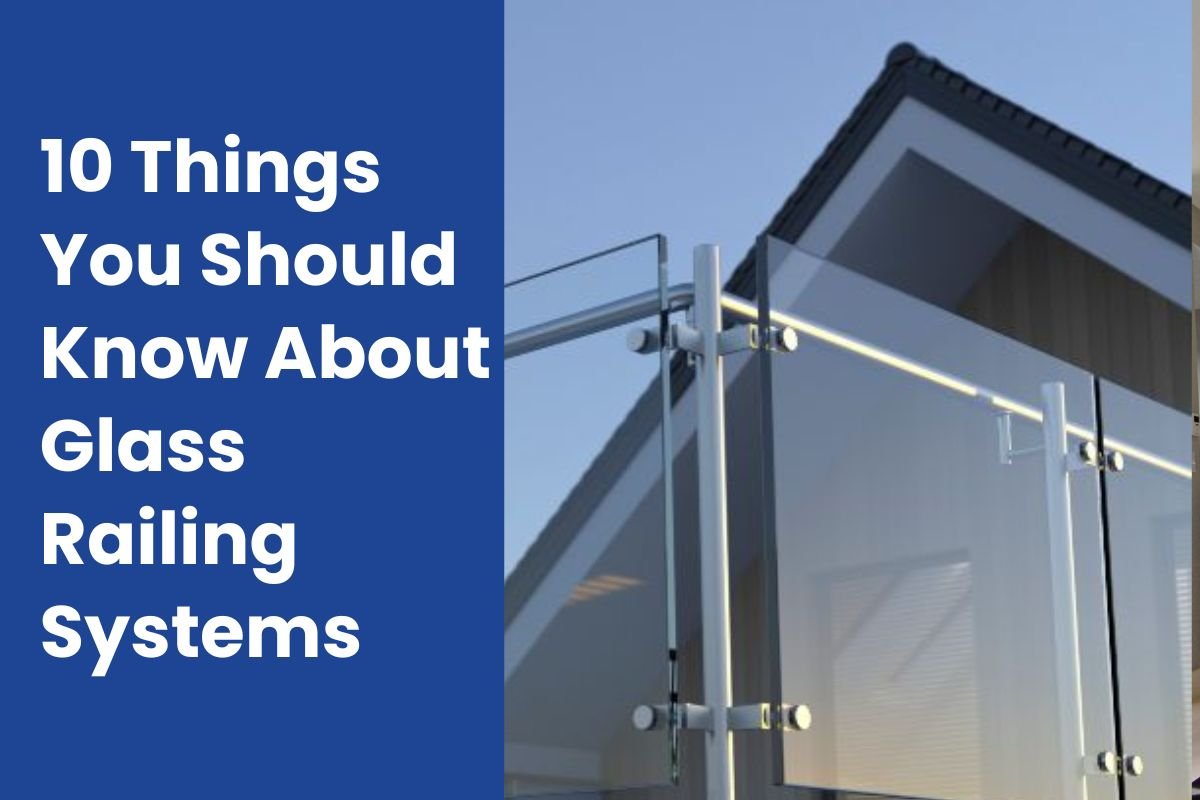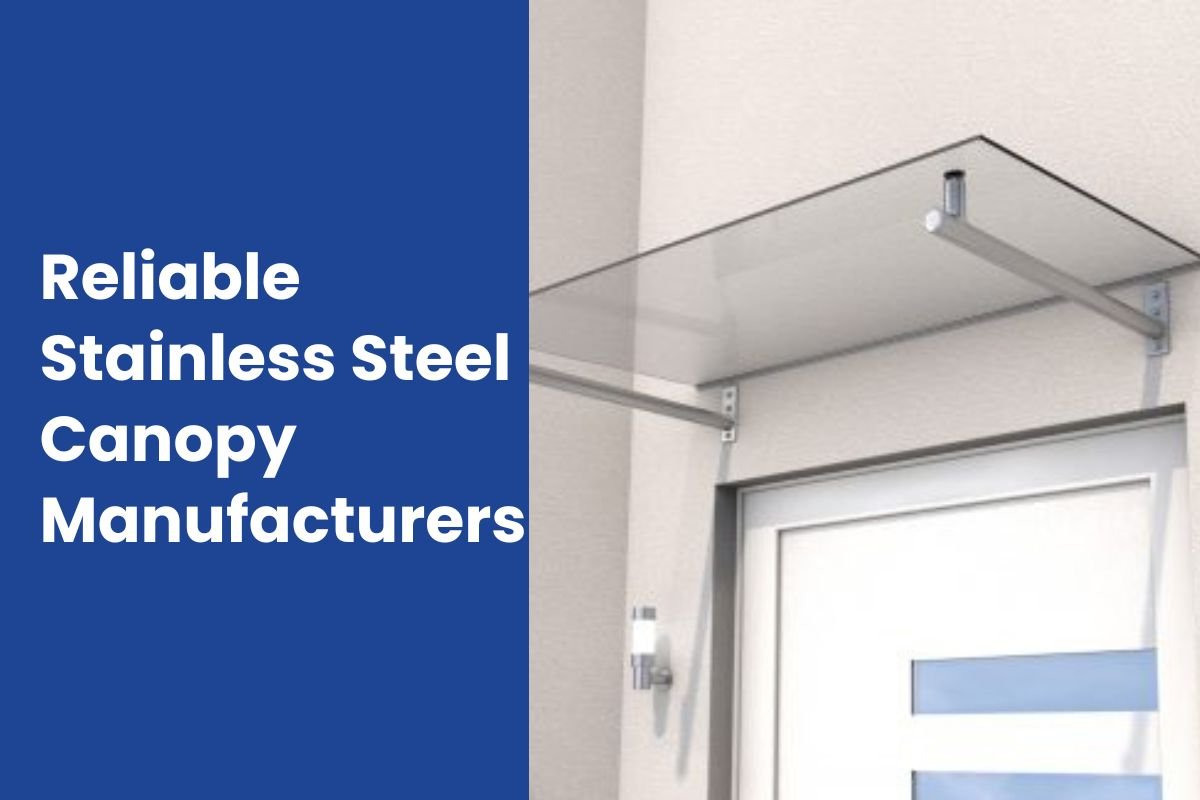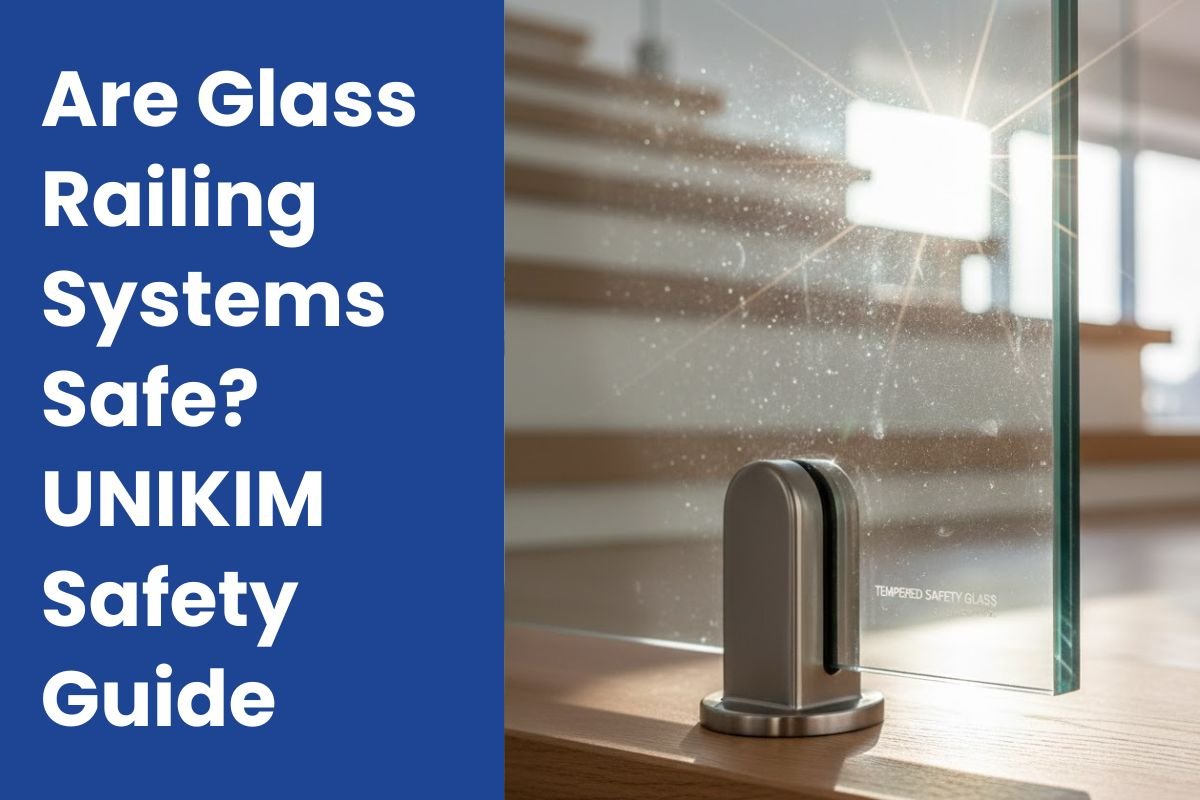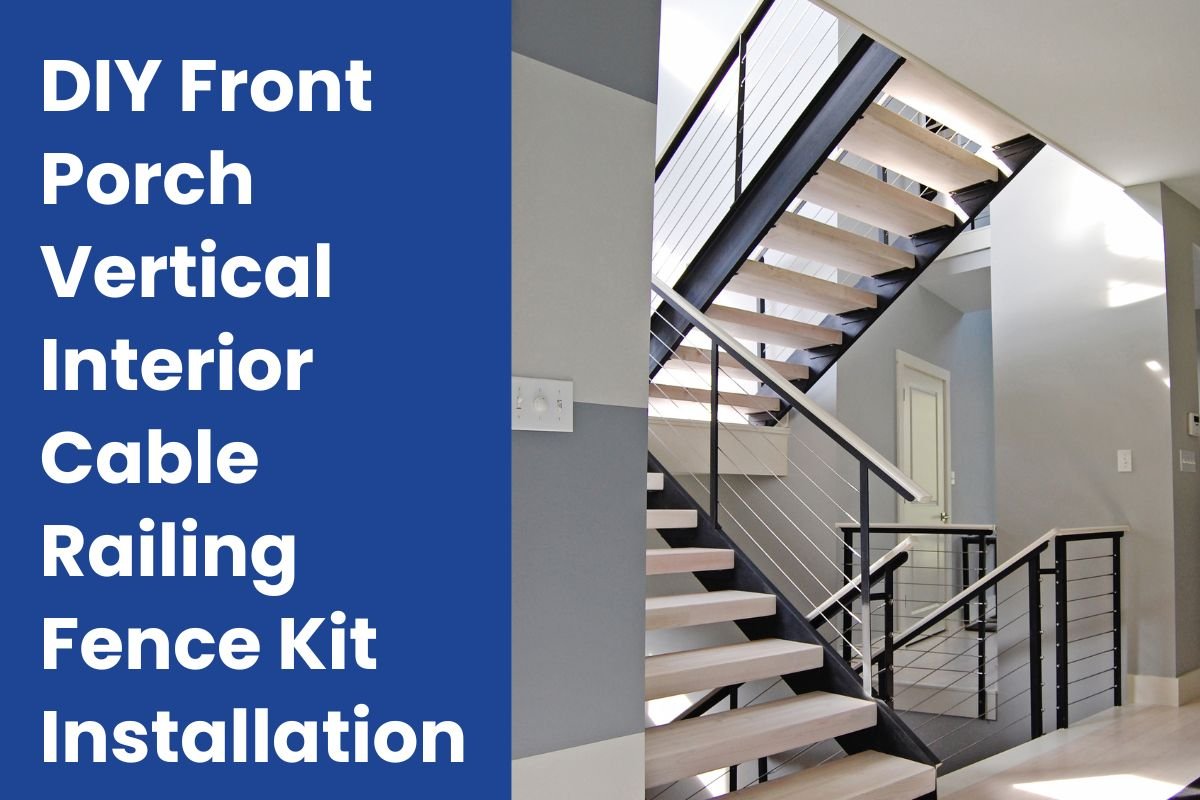Glass railing systems have become a popular choice for both residential and commercial spaces, offering a sleek, modern look while ensuring safety and durability. Whether you’re designing a balcony, staircase, or deck, glass railings can transform the aesthetic of any space. But with so many options available, how do you choose the right system for your needs? In this comprehensive guide, we’ll explore 10 essential aspects of glass railing systems, from cost and design to installation and maintenance. By the end, you’ll have the knowledge to make an informed decision for your next project.
The solution lies in high-quality glass railing systems. These systems have moved past simple functionality to become a defining feature in modern architecture, offering unhindered sightlines and a sleek finish. But selecting the right type, understanding material grades like AISI 304, 316, and 2205, and knowing the best installation methods is crucial. We’ve put together the ten most important considerations to guide your purchasing decisions on these sophisticated glass railing systems.
The Critical Difference: Frameless vs. Post-Supported Glass Railings
Choosing the right structure is the first, and perhaps most impactful, decision when specifying glass railing systems. The two primary styles are frameless and post-supported, each offering a distinct aesthetic and different installation considerations.
Frameless Glass Railing Systems: The Invisible Barrier
A frameless glass railing system achieves the ultimate clean look. The glass panels are held securely by an aluminum base shoe—a low-profile channel that runs along the bottom edge—or by stainless steel spigots. This method eliminates vertical posts entirely, providing a completely uninterrupted line of sight.
- Aesthetics: Pure, minimalist, and high-end. It makes small spaces feel larger and is perfect for locations where preserving the view is paramount, such as high-rise balconies or waterfront properties.
- Installation: Requires a robust, structurally sound mounting surface (like concrete or a thick structural beam) to handle all lateral load forces at the base. The installation of the glass railing shoe is precise, as the glass often requires an exacting fit into the channel or spigots.
- Cost: Generally higher than post-supported systems due to the demanding engineering of the base structure and the often thicker, more specialized glass required.
Post-Supported Glass Railing Systems: Practical Elegance
Post-supported, or metal and glass railing systems, use vertical balusters (posts) made from materials like high-grade stainless steel or aluminum to hold the glass panels in place. The glass is secured using clips or clamps attached to these posts.
- Aesthetics: Offers a cleaner, more contemporary look than cable or bar railings, while still being highly secure. Posts can be customized with various finishes, like matte black stainless steel 316 304 glass railing handrail.
- Installation: More flexible regarding mounting surfaces. The load is distributed among multiple posts, which simplifies engineering for applications like residential glass railing systems on wood decks or existing concrete surfaces.
- Cost: Typically more budget-friendly and quicker to install than a full frameless system, making them a popular choice for large commercial glass railing systems projects.
| Feature | Frameless System | Post-Supported System |
| Aesthetics | Completely uninterrupted view, floating glass | Clean, modern, but with visible vertical posts |
| Mounting | Base channel or spigots (high structural demand) | Vertical posts (more flexible structural demand) |
| Ideal Use | High-end balconies, pool fencing, premium interiors | Decks, high-traffic commercial stairs, budget-sensitive projects |
| Common Materials | Thick, usually tempered laminated glass | Tempered glass, stainless steel, or aluminum posts |
1. Material Quality Determines Longevity and Safety

ISI 304 works well for interior applications and dry climates. AISI 316 contains molybdenum, which provides superior corrosion resistance—essential for coastal environments or areas with de-icing salt exposure. For extreme marine conditions, duplex 2205 stainless steel offers even greater strength and longevity.
When evaluating glass railing systems, ask suppliers about their material certifications. Reputable manufacturers provide mill test reports confirming alloy composition. At Unikim Metals, we manufacture exclusively in AISI 304, 316, and 2205 grades, backed by CE certification and SGS testing. This isn’t just about meeting minimum standards—it’s about ensuring your installation performs flawlessly for decades.
Aluminum systems offer a lightweight alternative, particularly popular in residential glass railing systems. They resist rust naturally and accept powder coating for custom color finishes. Zinc alloy components provide budget-friendly options for interior projects where structural demands are lower.
The base shoe or channel that holds glass panels deserves special attention. A poorly designed glass railing shoe can crack tempered glass during thermal expansion or create water-trapping pockets that corrode fasteners. Quality shoes feature rounded interior edges and drainage channels.
2. Frameless vs. Framed Systems: More Than Aesthetics
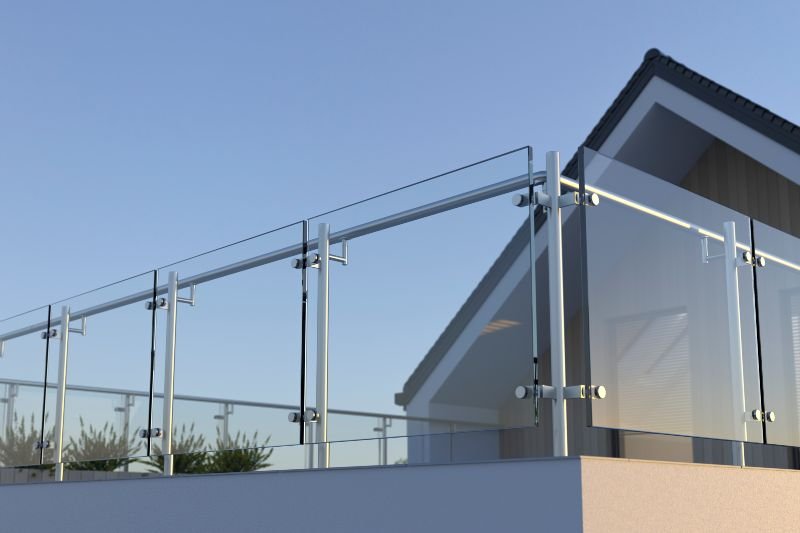
A frameless glass railing system maximizes visibility by eliminating vertical posts between panels. Glass attaches directly to the deck surface via base-mounted clamps or spigots. This design creates clean sight lines perfect for scenic locations. However, it requires thicker glass (typically 12mm or 1/2″) and precise installation to handle lateral loads without intermediate support.
Framed systems use top and bottom rails—often aluminum or stainless steel—to hold thinner glass panels (8-10mm). The frame distributes forces across the entire railing length, reducing stress on individual panels. This approach costs less and simplifies installation, making it popular for commercial glass railing systems where budget and speed matter.
Semi-frameless designs split the difference. They use a base channel with exposed glass edges on top and sides. You get cleaner aesthetics than fully framed systems while maintaining easier installation than true frameless designs.
Your choice impacts more than appearance. Building codes often dictate minimum glass thickness and attachment methods based on railing height and exposure. A knowledgeable glass railing systems supplier helps navigate these requirements during the planning phase.
3. Glass Type and Treatment Affect Performance

Building codes universally require tempered or laminated glass for railing applications. Tempered glass undergoes heat treatment that makes it four to five times stronger than standard annealed glass. When it breaks, it shatters into small, relatively harmless cubes rather than dangerous shards.
Laminated glass sandwiches a polymer interlayer between two glass sheets. If breakage occurs, fragments adhere to the interlayer instead of falling. This makes laminated glass ideal for elevated installations like second-story glass railing for balcony applications.
Tinted or frosted glass adds privacy without sacrificing light. Low-iron glass (ultra-clear) eliminates the green tint visible in standard glass edges, creating a truly transparent appearance. These specialty options increase glass railing systems cost by 15-40% but deliver unique aesthetic value.
Edge finishing matters too. Polished edges look cleaner but cost more than seamed edges. Flat polished edges work for framed systems where edges hide in channels. Exposed edges in frameless installations demand polished finishes for both appearance and safety.
4. Load Requirements Vary by Application and Location
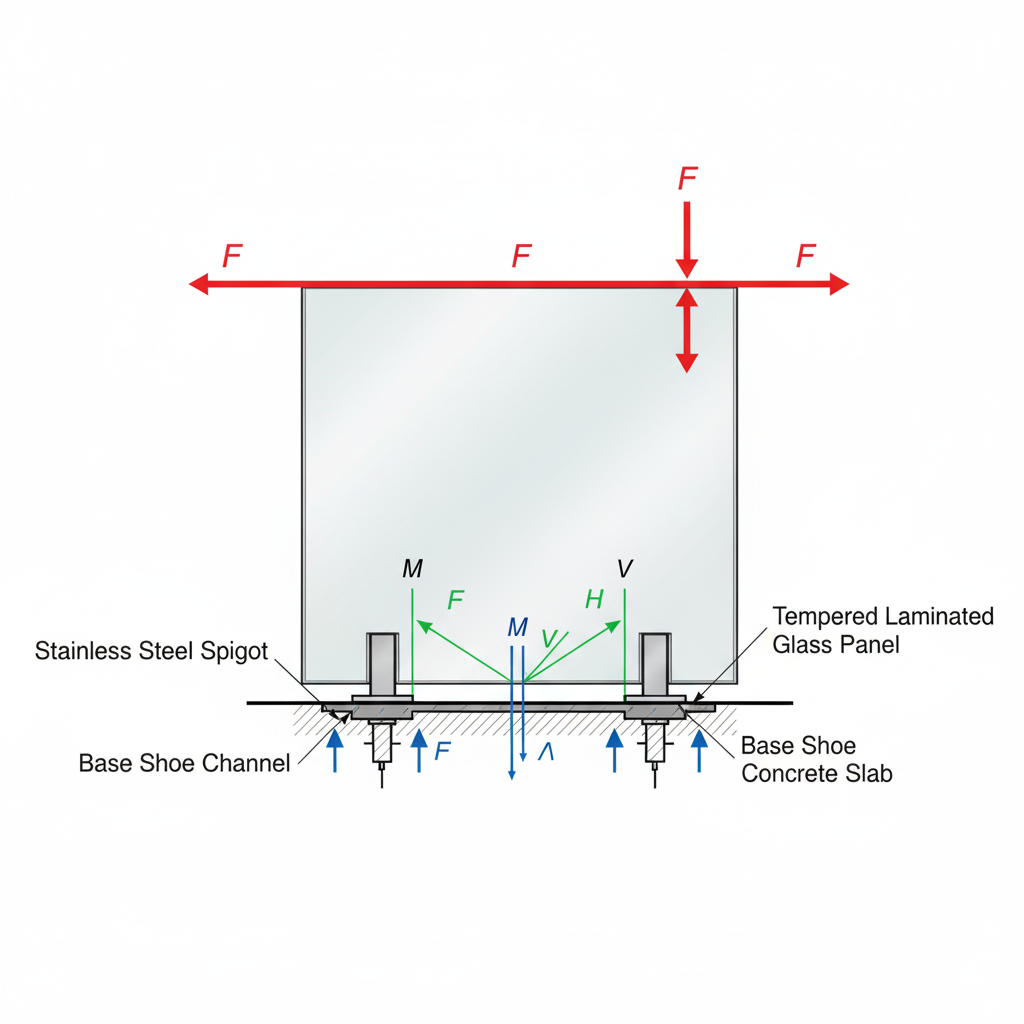
Residential codes in North America typically require railings to withstand 200 pounds of horizontal force applied at any point along the top rail. Commercial applications often demand 50 pounds per linear foot—significantly higher loads that necessitate stronger components and closer post spacing.
Glass railing systems for stairs face additional complexity. Stairs create dynamic loads as people ascend and descend. The railing must handle both horizontal push forces and vertical downward loads from people gripping handrails. This often requires continuous handrails mounted atop glass panels rather than relying on glass edges alone.
Regional wind loads also factor into specifications. Coastal areas and high-rise buildings experience greater wind pressures. Engineers calculate design loads based on building height, location, and exposure category. A ground-floor glass railing systems for decks installation faces different demands than an eighth-floor terrace.
Snow accumulation affects horizontal railings in cold climates. Drifted snow adds significant weight and lateral pressure. Quality manufacturers provide engineering data showing how their systems perform under combined load scenarios—not just individual test results taken in isolation.
5. Installation Methods Impact Labor Costs and Flexibility
Surface mounting attaches railing posts directly to the deck or floor surface. This method works with any substrate—wood, concrete, steel, or composite decking. Structural integrity depends on proper fastener selection and substrate thickness. Surface-mounted systems simplify retrofits and repairs since you’re not penetrating side surfaces.
Fascia mounting secures posts to the side face of a deck or balcony. This creates a cleaner look by eliminating visible baseplates. However, it requires adequate blocking behind the fascia board to distribute loads. Not all existing structures can accept fascia mounting without reinforcement.
Core mounting involves drilling through the deck surface and bolting posts to the supporting structure beneath. This provides maximum strength but requires access to framing members. It’s common in new construction but challenging in retrofit scenarios.
Some indoor glass railing systems Canada projects use channel systems where glass panels slide into continuous aluminum tracks. This speeds installation and allows for future panel replacement without disassembling entire sections. Channel-mounted systems work particularly well for glass railing systems interior applications like mezzanines or open-plan offices.
6. Code Compliance Isn’t Optional
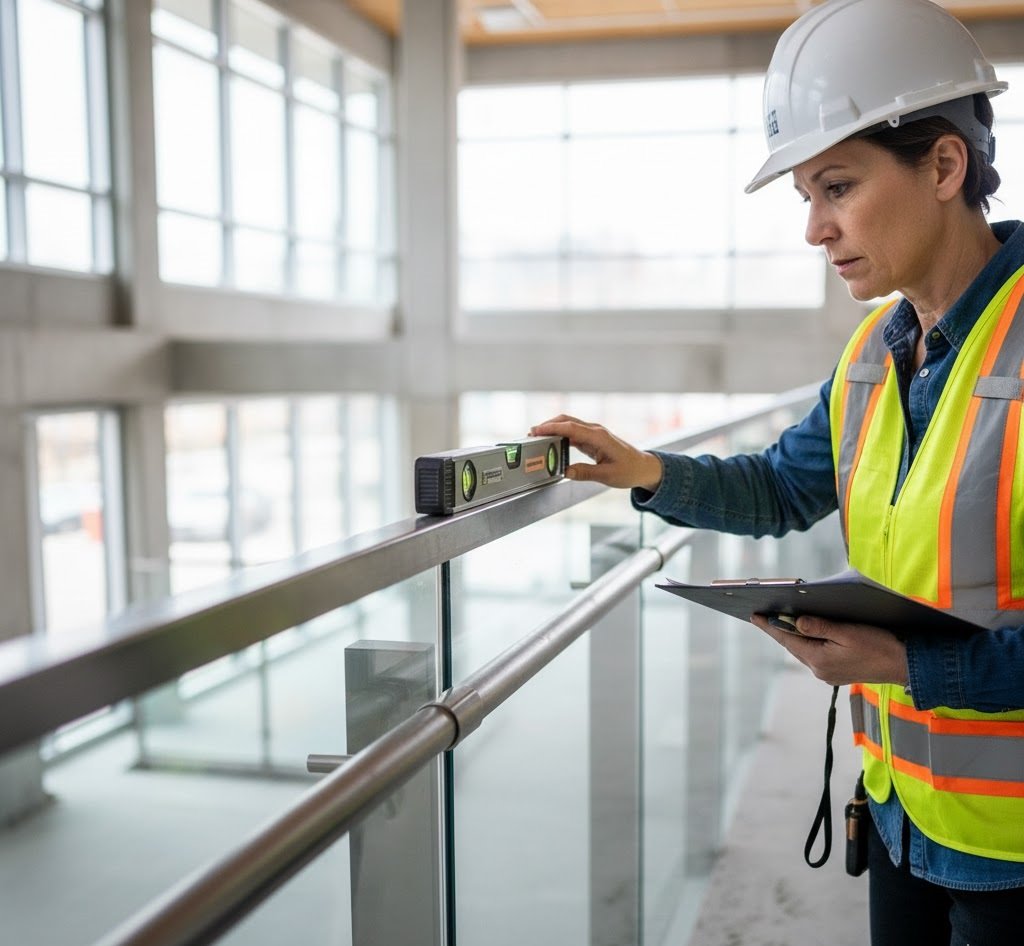
International Building Code (IBC) and International Residential Code (IRC) set baseline requirements for railing height, spacing, and load capacity. Most jurisdictions adopt these standards with local amendments. Minimum railing height is typically 36 inches for residential stairs and 42 inches for commercial applications.
The “four-inch sphere rule” prevents children from passing through or becoming trapped in openings. Any gap in your railing system must be small enough that a four-inch diameter sphere cannot pass through. This affects spacing between glass panels and the gap beneath the bottom rail.
Handrail requirements differ from guard rail (railing) requirements. Stairs need graspable handrails separate from the infill panels. The handrail must be continuous, return to walls or posts at ends, and maintain consistent height along the stair run. Stainless steel railing end caps provide code-compliant terminations that prevent clothing from catching.
Tempered glass used in railings must be permanently marked with the manufacturer’s identifier and “CPSC 16 CFR 1201 Cat II” or equivalent certification. This mark is usually sandblasted or ceramic-fired in a corner—look for it when receiving materials. Missing marks may indicate non-compliant glass that inspectors will reject.
7. Maintenance Requirements Differ by System Type
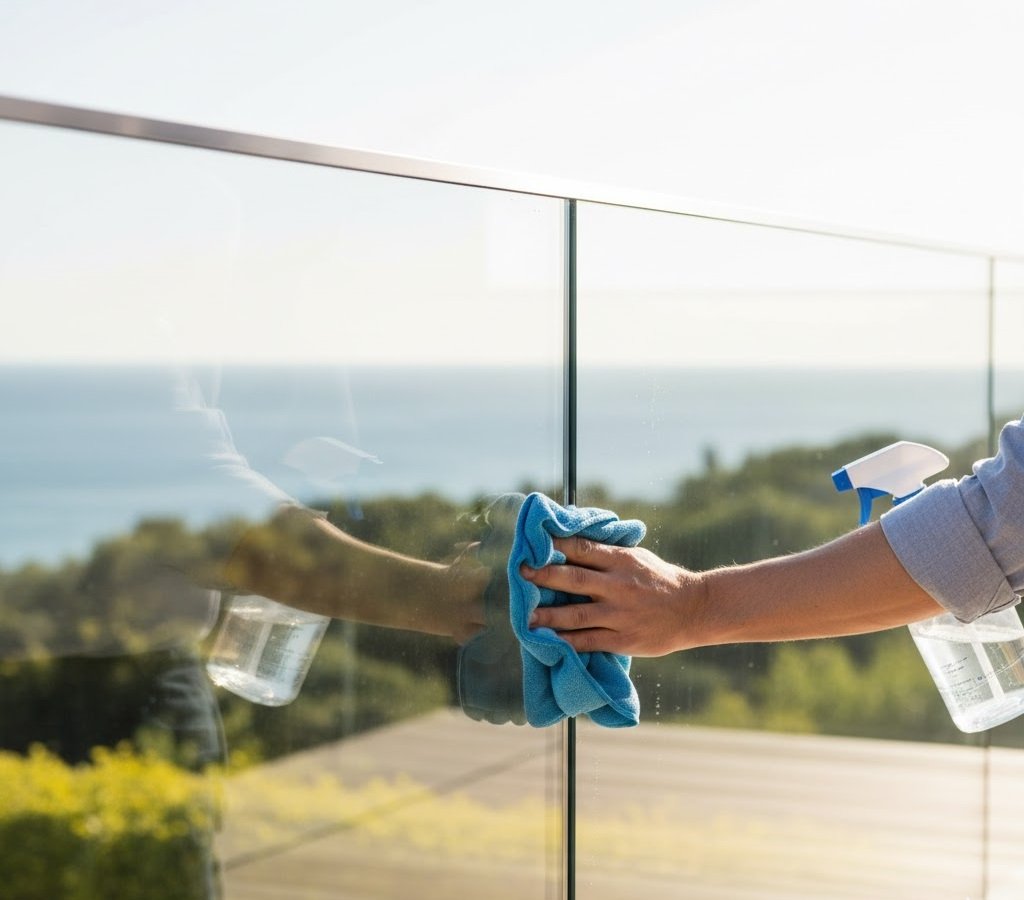
Glass panels require regular cleaning to maintain clarity. Coastal installations and areas with hard water need more frequent attention. Standard glass cleaners work fine, but avoid abrasive materials that scratch surfaces. Soft microfiber cloths or squeegees prevent streaking.
Stainless steel components can develop surface rust spots if exposed to iron contamination—like metal particles from nearby grinding operations. These “rust stains” aren’t true corrosion of the stainless steel itself. Remove them with dedicated stainless steel cleaners or mild acid solutions. Rinse thoroughly afterward.
Hardware inspection should occur annually. Check mounting bolts for tightness, examine welds for cracks, and verify that threaded connections haven’t loosened from thermal cycling or vibration. Coastal installations benefit from semi-annual inspections due to accelerated corrosion potential.
Moving parts like gates or removable panels need occasional lubrication. Use dry lubricants or marine-grade grease that won’t attract dirt. Avoid petroleum-based products that can degrade rubber gaskets or leave residue that collects grime.
Proper initial installation reduces long-term maintenance. Systems with adequate drainage don’t trap water against fasteners. Glass railing system aluminum profiles with integrated drainage channels outperform designs that pocket moisture.
8. Cost Factors Extend Beyond Materials
Material selection forms the foundation of glass railing systems cost. Aluminum systems start around $150-200 per linear foot installed for basic residential applications. Stainless steel frameless systems run $300-450 per foot. Specialty finishes like brushed black or powder-coated colors add 20-30% to base prices.
Glass thickness and treatment significantly impact pricing. Standard 1/2″ tempered clear glass costs substantially less than 3/4″ low-iron laminated glass. Curved or custom-shaped panels require specialized fabrication that doubles or triples glass costs.
Installation complexity affects labor expenses. Retrofitting glass railings onto existing structures costs more than new construction installations. Difficult access—like high-rise balconies—increases labor time and equipment needs. Projects requiring engineering stamps and permit fees add professional service costs.
Shipping represents a hidden expense, especially for fragile glass panels. Proper crating and freight insurance protect your investment but increase delivered costs. Local suppliers save on shipping but may offer limited selection. Importing directly from manufacturers like Unikim Metals reduces per-unit costs on volume orders despite freight charges.
Long-term costs matter too. A cheap system requiring replacement after five years costs more than a quality installation lasting 25+ years. Factor in maintenance frequency, replacement part availability, and warranty coverage when calculating true lifetime costs.
9. Customization Options Match Project Requirements
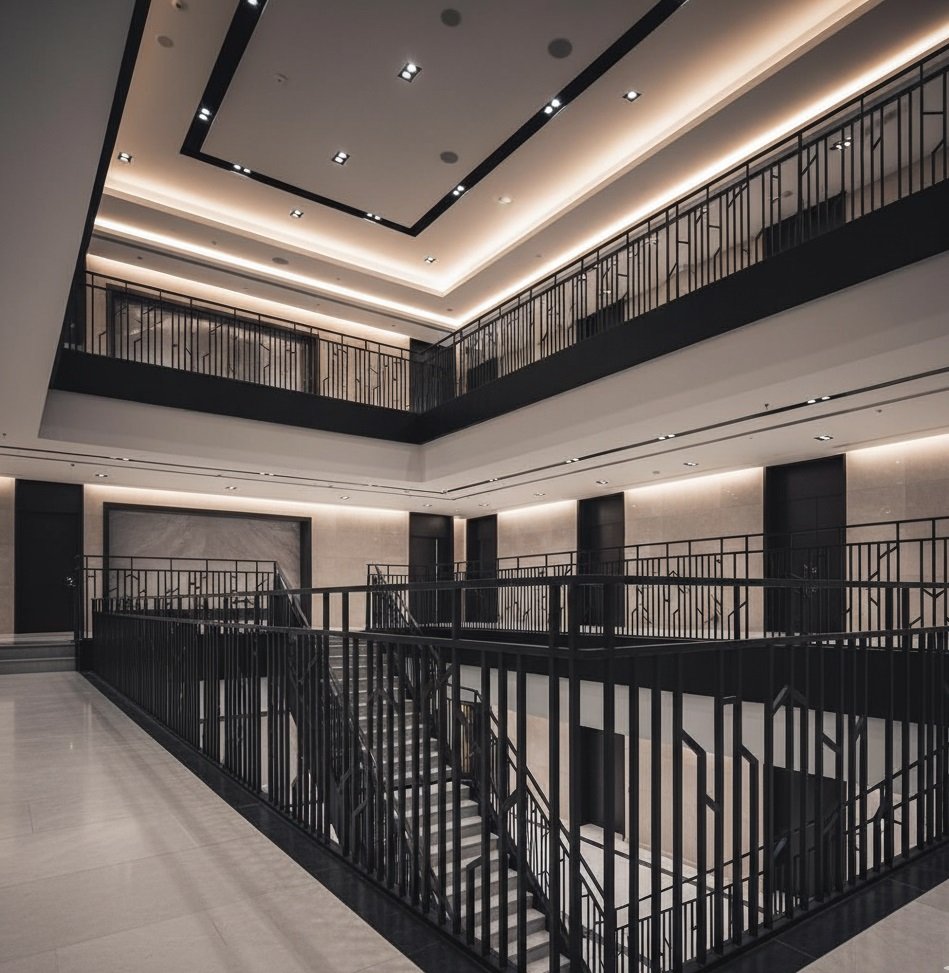
Standard systems work for straight runs and 90-degree corners. Complex projects need customization. Curved glass panels follow rounded balconies or sweeping staircases. Angled connections accommodate non-rectangular layouts. Adjustable fittings handle out-of-plumb posts or uneven substations.
Finish options let you match existing architecture. Polished stainless steel creates high-gloss reflections. Satin or brushed finishes hide fingerprints and integrate with contemporary design. Powder-coated aluminum accepts virtually any color—though dark colors may fade faster in direct sunlight.
The matte black stainless steel glass railing handrail has become increasingly popular in modern architecture. PVD coating creates durable black finishes that resist chipping better than powder coating. These premium finishes add 40-60% to component costs but deliver unique visual impact.
Height customization addresses specific code requirements or user preferences. Standard 36-42 inch heights suit most applications, but some projects need 48-inch railings for added security. Taller railings require engineering to verify stability against overturning forces.
OEM and ODM capabilities mean manufacturers can produce components to your specifications. Custom post spacing, specialized mounting brackets, or unique handrail profiles become feasible when working with experienced manufacturers. Minimum order quantities typically apply—expect 50-100 linear feet for fully custom components.
10. Supplier Selection Impacts Project Success
Not all suppliers offer equal value. Retailers mark up manufacturer prices by 50-100%. Distributors provide local inventory but limited customization. Working directly with manufacturers eliminates middleman costs while accessing full product ranges.
Certifications signal quality commitment. ISO 9001 demonstrates consistent manufacturing processes. CE marking confirms European safety standards—increasingly required for international projects. SGS certification validates material composition and performance testing.
Technical support separates good suppliers from great ones. Can they provide CAD drawings for custom configurations? Do they offer load calculations and engineering assistance? Will they review your project specifications before quoting? Professional suppliers employ technical sales teams who understand both products and applications.
Communication matters enormously in international sourcing. Language barriers cause specification errors, shipping delays, and quality disputes. Manufacturers with English-speaking sales teams prevent costly miscommunications. At Unikim Metals, our professional sales team fluently handles technical discussions, ensuring your requirements translate accurately to production.
Lead times vary by supplier. Stocked items ship within days. Custom orders may require 4-8 weeks for fabrication plus shipping time. Plan accordingly—especially for projects with fixed completion dates. Suppliers with broad inventories of OEM stainless steel glass railing accessories offer faster delivery on standard components.
After-sales support ensures long-term satisfaction. Can you order replacement parts years later? Does the supplier stand behind their products when issues arise? Companies established for 20+ years demonstrate staying power and accountability that newer operations can’t match.
Conclusion
Selecting the right glass railing system requires balancing aesthetics, performance, compliance, and cost. Start with a clear understanding of your project requirements—interior versus exterior, residential versus commercial, standard versus custom. Evaluate material grades appropriate for your environment. Choose between frameless, framed, or semi-frameless designs based on budget and sight line priorities.
Work with suppliers who provide engineering support, certifications, and responsive communication. Don’t sacrifice quality for marginal cost savings—proper systems last decades while cheap alternatives fail prematurely. Consider total lifetime costs including maintenance and replacement rather than focusing solely on initial purchase price.
FAQs
Q: What’s the typical lead time for custom glass railing systems from a manufacturer?
A: Standard components ship within 5-10 business days from inventory. Custom configurations requiring specialized fabrication typically need 4-6 weeks for production, plus 2-4 weeks for international shipping depending on destination. Projects requiring engineering calculations or custom finishes may extend timelines by 1-2 weeks.
Q: How do I calculate the quantity of materials needed for my glass railing project?
A: Measure total linear footage of railing sections, including stairs if applicable. Calculate the number of glass panels by dividing linear footage by your desired panel width (typically 3-5 feet between posts for frameless systems). Count corner posts, end posts, and intermediate posts based on your layout.
Q: Can glass railing systems be installed on existing wooden decks, or do they require special reinforcement?
A: Many wooden decks can support glass railing systems with proper assessment. Surface-mounted posts require solid blocking beneath fastener locations to distribute loads. Deck joists must be in good condition without rot or structural damage. Fascia-mounted systems need adequate rim joist backing—typically 2×8 or larger lumber. Older decks or those built to minimum code may require reinforcement.
Q: How do material certifications impact project approval and insurance for commercial glass railing installations?
A: Building inspectors require documentation proving materials meet code requirements. Material test reports from mills verify stainless steel grades and composition. CE marking demonstrates European safety standard compliance, increasingly required for international projects and institutional work.

